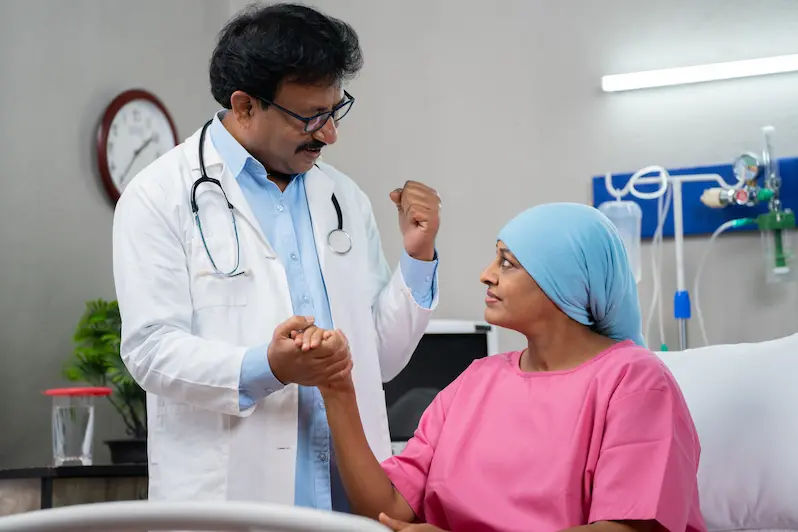Endometrial Cancer Symptoms, Risk Factors, and Treatment Options
Learn about endometrial cancer symptoms, risk factors, diagnosis, and treatment options. Trusted women’s health guide with tips on prevention and care.


Introduction
Endometrial cancer is the most common cancer of the female reproductive system in many countries. It begins in the lining of the uterus (the endometrium) and often shows early warning signs, especially abnormal vaginal bleeding. Knowing the symptoms, understanding your risk, and seeking timely care can make a real difference. This friendly guide walks you through what to watch for, how doctors diagnose it, and the treatment options available so you can make informed choices about your women’s health.
What is endometrial cancer?
Endometrial cancer starts in the inner lining of the uterus. It is sometimes called uterine cancer, though “uterine cancer” also includes rarer tumors called uterine sarcomas. Most cases are found early because abnormal bleeding prompts people to see their clinician. Finding it early usually leads to more treatment options and better outcomes.
Symptoms and warning signs of endometrial cancer
The most common early symptom is abnormal vaginal bleeding.
Watch for:
• Bleeding or spotting after menopause (even a small amount deserves evaluation)
• Bleeding between periods or unusually heavy or prolonged periods
• Watery, pink, or blood-tinged vaginal discharge
• Pelvic pain or pressure
• Pain during sex
• Unexplained weight loss or fatigue (more often with advanced disease)
When to see a clinician?
• If you are postmenopausal and notice any bleeding or spotting, make an appointment promptly.
• If you have not gone through menopause and your periods are very heavy, irregular, or you bleed between periods, talk with your clinician.
• Seek urgent care if bleeding is heavy enough to soak through pads/hour or causes dizziness or fainting.Consult a Top General Physician
Who is at higher risk? Key risk factors
Many risk factors relate to lifelong exposure to estrogen not balanced by progesterone. Having one or more risk factors does not mean you will get endometrial cancer, but it’s helpful to be aware.
Higher risk is associated with
Age: Risk increases as you get older, especially after menopause.
Excess body weight: Obesity raises estrogen levels made by fat tissue and is a strong risk factor.
Estrogen exposure without progesterone
• Estrogen-only hormone therapy after menopause
• Early first period or late menopause (more menstrual cycles over a lifetime)
• Never having been pregnant
• Irregular ovulation or long stretches without ovulation (for example, polycystic ovary syndrome)
• Certain medicines: Tamoxifen (used for breast cancer) slightly increases risk; benefits often outweigh risks, but monitoring is important.
• Medical conditions: Diabetes is linked to higher risk (partly due to overlapping factors like obesity).
Family and genetic factors
• Lynch syndrome (hereditary nonpolyposis colorectal cancer) markedly raises the risk of endometrial and colorectal cancers.
• A family history of endometrial or colorectal cancer may signal inherited risk.
• Past pelvic radiation therapy (for other cancers)
• Precancerous changes of the uterus lining (atypical endometrial hyperplasia or endometrial intraepithelial neoplasia)
Protective factors may include
• Using combined oral contraceptives (the pill) for several years (the reduced risk can last long after stopping)
• Using a progestin-releasing intrauterine device (IUD), which helps counteract estrogen’s effects on the uterine lining
• Maintaining a healthy body weight and staying physically active
How is endometrial cancer diagnosed?
Diagnosis typically starts after symptoms appear. There is no routine screening test for endometrial cancer for people at average risk.
Common steps include
• Medical history and pelvic exam: Your clinician will ask about bleeding patterns and other symptoms.
• Transvaginal ultrasound: An ultrasound probe placed in the vagina helps measure the thickness and appearance of the uterine lining. It can also look for polyps, fibroids, or other causes of bleeding.
• Endometrial biopsy: A thin tube is passed through the cervix to take a small sample of the uterine lining. This is usually done in the office and is the key test to confirm or rule out cancer.
• Hysteroscopy with dilation and curettage (D&C): If the biopsy is inconclusive or a closer look is needed, the clinician can inspect the uterus with a tiny camera and collect targeted tissue samples.
• Pathology and staging: If cancer is found, surgery often provides both treatment and staging information (how far the cancer has grown). The stage guides additional therapy.
Treatment options for endometrial cancer
Your care team will tailor treatment to the cancer’s stage, grade, and type, as well as your overall health and preferences. Most people receive more than one type of treatment.
Surgery
• Standard surgery is a hysterectomy (removal of the uterus), often with removal of both ovaries and fallopian tubes (bilateral salpingo-oophorectomy).
• Lymph nodes may be sampled or mapped (sentinel lymph node biopsy) to check for spread.
• Many surgeries are done minimally invasively (laparoscopic or robotic), which can mean smaller incisions and faster recovery.
Radiation therapy
• External beam radiation uses targeted X-rays to the pelvis.
• Vaginal brachytherapy places a radiation source in the vagina to lower the risk of cancer returning there.
• Radiation may be used after surgery based on risk features, or instead of surgery if someone is not a surgical candidate.
Chemotherapy
• Chemotherapy circulates through the bloodstream to treat cancer cells throughout the body.
• A common combination is carboplatin plus paclitaxel for higher-risk, advanced, or recurrent disease.
• Chemo may be given after surgery or with radiation in selected cases.
Hormone therapy
• Some endometrial cancers are sensitive to hormones. Progestins (pills, injections, or a levonorgestrel-releasing IUD) can slow or stop growth.
• Hormone therapy is often used for advanced or recurrent disease, or as part of fertility-sparing treatment in carefully selected early, low-grade cases under close supervision.
Immunotherapy and targeted therapy
• For tumors with certain biomarkers (like mismatch repair deficiency or high microsatellite instability), immune checkpoint inhibitors such as pembrolizumab or dostarlimab can be effective in advanced or recurrent disease.
• For tumors without those biomarkers, pembrolizumab combined with lenvatinib is an option for some people with previously treated advanced disease.
• For certain aggressive types (like uterine serous cancers) with HER2 overexpression, adding HER2-targeted therapy (such as trastuzumab) to chemotherapy may be considered.
Fertility-sparing options for select patients
• In very carefully chosen cases (typically grade 1, presumed early-stage cancer confined to the lining), high-dose progestin therapy, often with a progestin IUD, may be used to preserve fertility.
• This approach requires close monitoring with repeat biopsies and a clear plan for definitive treatment (surgery) after childbearing or if the cancer does not respond.
Side effects and supportive care
• Surgery: temporary pain, fatigue; possible menopause symptoms if ovaries are removed.
• Radiation: bowel or bladder irritation, fatigue, vaginal dryness or narrowing (vaginal dilators and lubricants can help).
• Chemotherapy: hair loss, nausea, lowered blood counts, neuropathy (tingling/numbness).
• Hormone therapy: fluid retention, mood changes, potential weight changes.
• Immunotherapy/targeted therapy: can cause immune-related side effects or blood pressure/thyroid changes; regular monitoring is important.
Ask your care team about nutrition, physical activity, sexual health, and emotional support; these are essential parts of recovery and long-term well-being.
Outlook, follow-up, and survivorship
• Many cases are found early, when treatment is most effective.
• After treatment, regular follow-up helps catch any recurrence early and manage late effects. Your schedule may look like visits every few months for the first years, then less often, but your plan will be personalized.
• Call your clinician sooner if you notice new vaginal bleeding, pelvic pain or pressure, unexplained weight loss, persistent cough, or new neurologic symptoms.
Prevention and self-advocacy in women’s health
While not all cases can be prevented, you can lower your risk and support early detection:
• Maintain a healthy weight and stay active most days of the week.
• Manage conditions like diabetes and PCOS with your clinician’s guidance.
• Discuss hormone therapy: If you use estrogen after menopause, make sure you are taking it safely (usually with progesterone if you still have a uterus).
• Ask about tamoxifen risks and benefits if you use it for breast cancer; report any vaginal bleeding promptly.
• Consider birth control options: Combined oral contraceptives and progestin IUDs can lower risk.
• Know your family history: If relatives have had endometrial or colorectal cancer (especially at younger ages), ask about genetic counseling to evaluate for Lynch syndrome. People with Lynch syndrome may benefit from earlier evaluation and risk-reducing strategies.
• Don’t ignore bleeding: Postmenopausal bleeding is never “normal” and always deserves evaluation.Consult a Top General Physician
Questions to ask your clinician
• What is my cancer’s stage and grade, and what does that mean for treatment?
• Do I need surgery, radiation, chemotherapy, hormone therapy, or a combination?
• Do my tumor’s biomarkers suggest immunotherapy or targeted therapy options?
• Could a fertility-sparing approach be safe for me?
• What side effects should I expect, and how can we prevent or manage them?
• How often will I need follow-up visits and tests?
Consult a Top General Physician

Dr. Arif Ahmed
General Physician/ Internal Medicine Specialist
9 Years • MBBS, MD (Genl. Med.)
Kolkata
MCR SUPER SPECIALITY POLY CLINIC & PATHOLOGY, Kolkata

Dr. Utsa Basu
Diabetologist
14 Years • MBBS , MD
Barasat
Diab-Eat-Ease, Barasat
(75+ Patients)

Dr. Abhishek Ranjan
General Practitioner
4 Years • MBBS
Kolkata
VDC Clinic, Kolkata

Dr. Nilotpal Mitra
General Physician/ Internal Medicine Specialist
20 Years • MBBS, PGDGM ( Geriatric Medicine), ACMDC (an Advance course in Diabetes and cardiovascular diseases from PHFI and WHF )
Kolkata
MCR SUPER SPECIALITY POLY CLINIC & PATHOLOGY, Kolkata
(25+ Patients)

Dr. Tapabrata Ray
General Physician/ Internal Medicine Specialist
4 Years • MBBS,DGM,CPMeC,ACMDC
Kolkata
MCR SUPER SPECIALITY POLY CLINIC & PATHOLOGY, Kolkata
Consult a Top General Physician

Dr. Arif Ahmed
General Physician/ Internal Medicine Specialist
9 Years • MBBS, MD (Genl. Med.)
Kolkata
MCR SUPER SPECIALITY POLY CLINIC & PATHOLOGY, Kolkata

Dr. Utsa Basu
Diabetologist
14 Years • MBBS , MD
Barasat
Diab-Eat-Ease, Barasat
(75+ Patients)

Dr. Abhishek Ranjan
General Practitioner
4 Years • MBBS
Kolkata
VDC Clinic, Kolkata

Dr. Nilotpal Mitra
General Physician/ Internal Medicine Specialist
20 Years • MBBS, PGDGM ( Geriatric Medicine), ACMDC (an Advance course in Diabetes and cardiovascular diseases from PHFI and WHF )
Kolkata
MCR SUPER SPECIALITY POLY CLINIC & PATHOLOGY, Kolkata
(25+ Patients)

Dr. Tapabrata Ray
General Physician/ Internal Medicine Specialist
4 Years • MBBS,DGM,CPMeC,ACMDC
Kolkata
MCR SUPER SPECIALITY POLY CLINIC & PATHOLOGY, Kolkata
More articles from Cancer
Frequently Asked Questions
1) Is endometrial cancer the same as uterine cancer?
Endometrial cancer is the most common type of uterine cancer and starts in the uterine lining. Uterine sarcomas are much less common and start in the muscle or supporting tissues of the uterus.
2) Can younger people get endometrial cancer?
Yes. It is more common after menopause, but younger people can develop it, particularly those with obesity, PCOS, or hereditary conditions like Lynch syndrome. Any unusual bleeding should be checked.
3) Is there a screening test for endometrial cancer?
There is no routine screening test for people at average risk. The most important step is to report abnormal bleeding. People with Lynch syndrome may need earlier and more frequent evaluation and should discuss options with a specialist.
4) Do birth control pills or IUDs change my risk?
Yes. Combined birth control pills and progestin-releasing IUDs lower the risk of endometrial cancer by balancing estrogen’s effects on the uterine lining. Your clinician can help you choose the safest option for your situation.
5) I have postmenopausal bleeding, what should I do?
See your clinician promptly. While many causes are benign (like thinning of the uterine lining or polyps), it can also be an early sign of endometrial cancer. Evaluation often includes an ultrasound and an endometrial biopsy.




